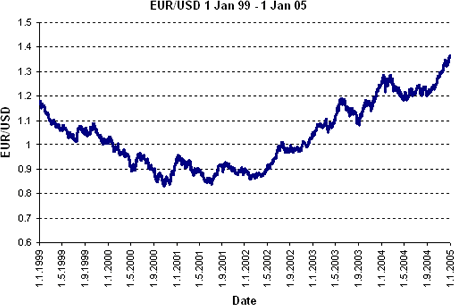

Euro Currency History
In those fouding documents, it was stated that that the economies of the Member States are a matter of common interest, but no concrete plans to unify currencies were made, partly due to the fact that the Bretton Woods system worked at the time (it pegged the European currencies to the U.S. dollar). In 1969 the heads of state and governments of the Member States for the Coal and Steel Community decided to investigate the possibility of setting up a monetary union. Things went as far as a resolution that was adopted, but it was never implemented in practice. When the Bretton Woods system collapsed in 1971, plans to set up a unified European currency were re-initiated. This resulted in a system commonly referred as a currency snake, where the European currencies were floating, but within set currency ceilings, which, when you look at a chart of the forex quotes and the ceilings, do resemple a "snake" pattern. This co-operation provided much needed stability to the European currencies during the economic instability of the 1970s. However, ambitions for a unified currency were much greater than that, and at the Bremen Summit in 1978, it was decided at the initiative of Germany and France to establish the European Monetary System (EMS). Euro Currency History - EMSThe ERM system was in effect a managed float, in which the currencies were allowed to move within a certain fluctuation band, but if one currency value varied too much against another, the central banks had the possibility to correct the situation by intervening in the forex market. This system worked well into the late 1980s, a time in history best marked by strong global economic growth. For the European countries and euro currency history, the economic progress also resulted in pressure to create a single internal economic market. The end result of those ambitions was the Single European Act, which was adopted in 1986. To further economic and monetary union within Europe, the Hannover Summit of 1988 draw up a plan to make economic and monetary union become a reality. Euro Currency History - 1990sThe plans from the Hannover Summit culminated in 1991 meeting of the 15 members of the European Union in the Dutch town of Maastricht, where the participants agreed to set up a single currency as part of the plans towards Economic and Monetary Union. The Maastrich Treaty also established European Central Bank to control price stability within European Community area. Soon after in the euro currency history, however, the Exchange Rate Mechanism of the EMS was put to test by currency speculators who believed that the European currencies were artificially strong due to the managed float. This resulted in massive speculation against all the major European currencies, and UK and several other European countries were forced to devalue their currencies. In the process, forex speculators made billions (it has been said that George Soros alone made $1 billion in one day by speculating that the GBP would be devalued. As it turned out, he was right.) Despite the collapse of the ERM system, The Maastrich Treaty entered into force in November 1993. According to the plan laid out in the Maastrich Treaty, the economic and monetary union was to be established in three stages and 1 January 1999 was the beginning of stage three. On January 1st, 1999, the euro was launched as an electronic currency used by banks, foreign exchange dealers, major companies, and stock markets. Since the launch, much of the speculation around the common currency has concentrated on not only the economies that make the EU, but also on the European Central Bank, whose authority over EU countries governments has been questioned throughout it's history. This has resulted in a lot of fluctuation on the currency's exchange rate, which has been especially evident against the U.S. dollar:  EUR/USD Chart Jan 1st, 1991 to Jan 1st, 2005 The latest chapter in the Euro currency history began on 1 January, 2002, when the euro became a cash currency for 300 million+ Euro area citizens in 12 member countries. The aim of the member states is to make the euro as strong international reserve currency as the U.S. dollar is. Also, the unified currency lowers the barriers to trade within the single economic area, which has been the core target ever since the first plans for unified European currency were laid out in late 1960s. |






















































